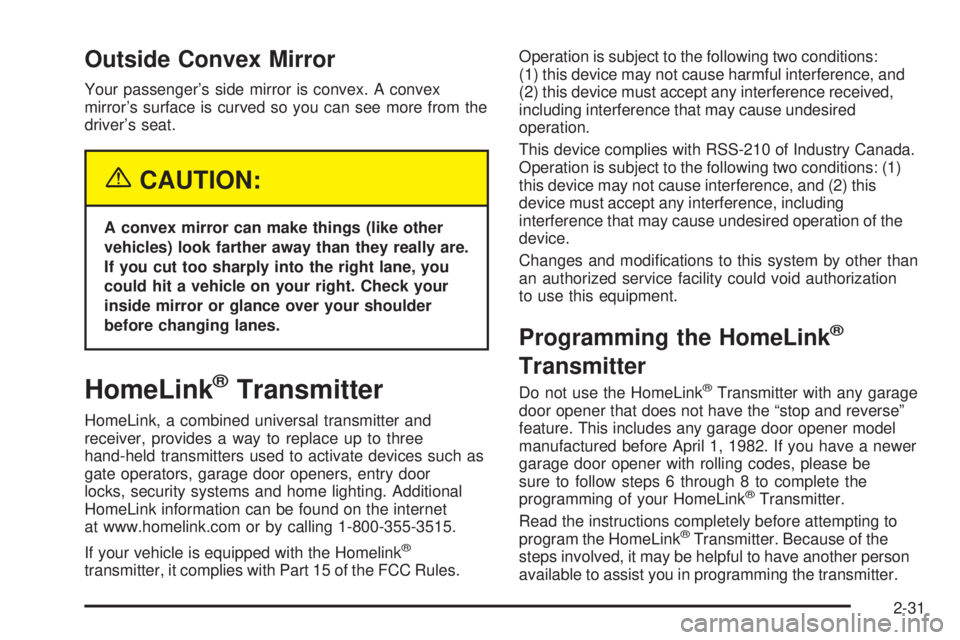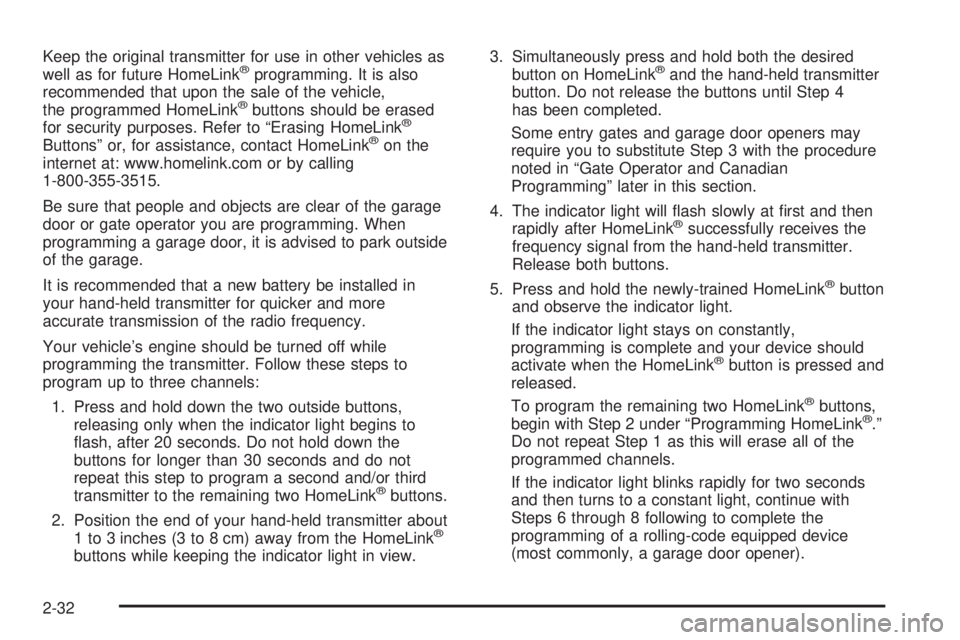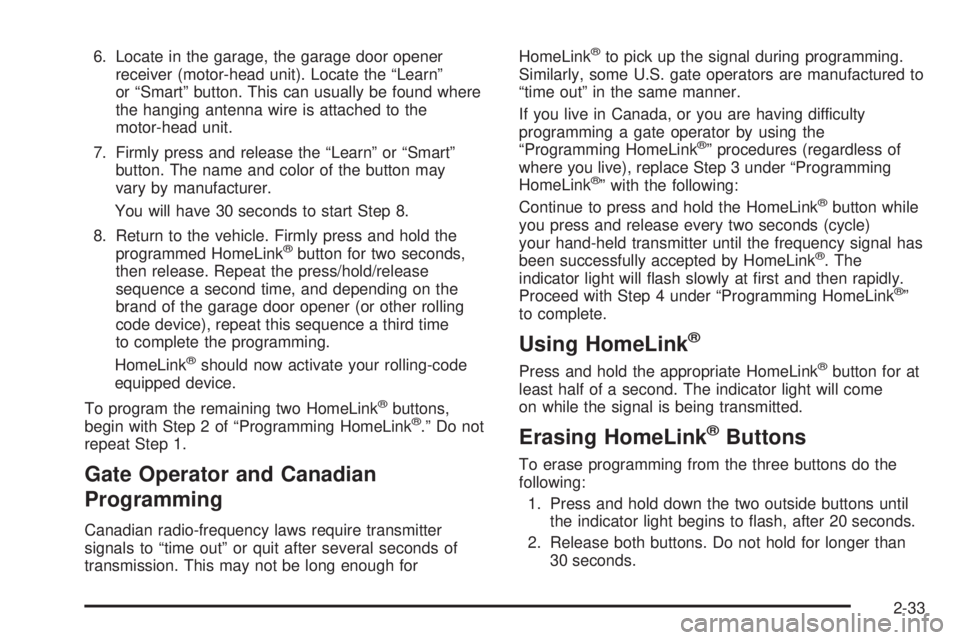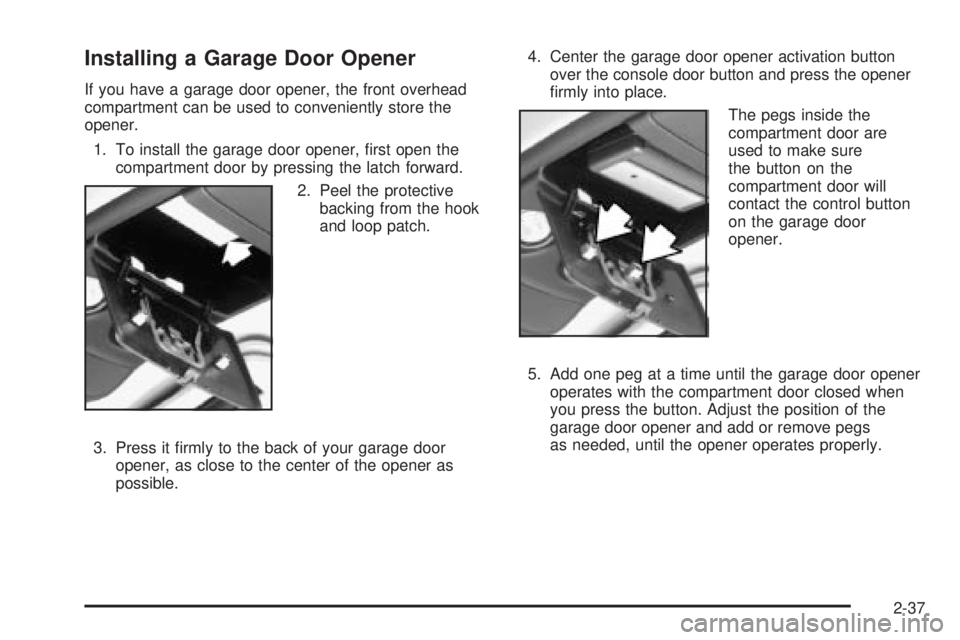2004 CHEVROLET ASTRO garage door opener
[x] Cancel search: garage door openerPage 109 of 382

Outside Convex Mirror
Your passenger's side mirror is convex. A convex
mirror's surface is curved so you can see more from the
driver's seat.
{CAUTION:
A convex mirror can make things (like other
vehicles) look farther away than they really are.
If you cut too sharply into the right lane, you
could hit a vehicle on your right. Check your
inside mirror or glance over your shoulder
before changing lanes.
HomeLinkžTransmitter
HomeLink, a combined universal transmitter and
receiver, provides a way to replace up to three
hand-held transmitters used to activate devices such as
gate operators, garage door openers, entry door
locks, security systems and home lighting. Additional
HomeLink information can be found on the internet
at www.homelink.com or by calling 1-800-355-3515.
If your vehicle is equipped with the Homelink
ž
transmitter, it complies with Part 15 of the FCC Rules.Operation is subject to the following two conditions:
(1) this device may not cause harmful interference, and
(2) this device must accept any interference received,
including interference that may cause undesired
operation.
This device complies with RSS-210 of Industry Canada.
Operation is subject to the following two conditions: (1)
this device may not cause interference, and (2) this
device must accept any interference, including
interference that may cause undesired operation of the
device.
Changes and modi®cations to this system by other than
an authorized service facility could void authorization
to use this equipment.
Programming the HomeLinkž
Transmitter
Do not use the HomeLinkžTransmitter with any garage
door opener that does not have the ªstop and reverseº
feature. This includes any garage door opener model
manufactured before April 1, 1982. If you have a newer
garage door opener with rolling codes, please be
sure to follow steps 6 through 8 to complete the
programming of your HomeLink
žTransmitter.
Read the instructions completely before attempting to
program the HomeLink
žTransmitter. Because of the
steps involved, it may be helpful to have another person
available to assist you in programming the transmitter.
2-31
Page 110 of 382

Keep the original transmitter for use in other vehicles as
well as for future HomeLinkžprogramming. It is also
recommended that upon the sale of the vehicle,
the programmed HomeLink
žbuttons should be erased
for security purposes. Refer to ªErasing HomeLinkž
Buttonsº or, for assistance, contact HomeLinkžon the
internet at: www.homelink.com or by calling
1-800-355-3515.
Be sure that people and objects are clear of the garage
door or gate operator you are programming. When
programming a garage door, it is advised to park outside
of the garage.
It is recommended that a new battery be installed in
your hand-held transmitter for quicker and more
accurate transmission of the radio frequency.
Your vehicle's engine should be turned off while
programming the transmitter. Follow these steps to
program up to three channels:
1. Press and hold down the two outside buttons,
releasing only when the indicator light begins to
¯ash, after 20 seconds. Do not hold down the
buttons for longer than 30 seconds and do not
repeat this step to program a second and/or third
transmitter to the remaining two HomeLink
žbuttons.
2. Position the end of your hand-held transmitter about
1 to 3 inches (3 to 8 cm) away from the HomeLink
ž
buttons while keeping the indicator light in view.3. Simultaneously press and hold both the desired
button on HomeLink
žand the hand-held transmitter
button. Do not release the buttons until Step 4
has been completed.
Some entry gates and garage door openers may
require you to substitute Step 3 with the procedure
noted in ªGate Operator and Canadian
Programmingº later in this section.
4. The indicator light will ¯ash slowly at ®rst and then
rapidly after HomeLink
žsuccessfully receives the
frequency signal from the hand-held transmitter.
Release both buttons.
5. Press and hold the newly-trained HomeLink
žbutton
and observe the indicator light.
If the indicator light stays on constantly,
programming is complete and your device should
activate when the HomeLink
žbutton is pressed and
released.
To program the remaining two HomeLink
žbuttons,
begin with Step 2 under ªProgramming HomeLinkž.º
Do not repeat Step 1 as this will erase all of the
programmed channels.
If the indicator light blinks rapidly for two seconds
and then turns to a constant light, continue with
Steps 6 through 8 following to complete the
programming of a rolling-code equipped device
(most commonly, a garage door opener).
2-32
Page 111 of 382

6. Locate in the garage, the garage door opener
receiver (motor-head unit). Locate the ªLearnº
or ªSmartº button. This can usually be found where
the hanging antenna wire is attached to the
motor-head unit.
7. Firmly press and release the ªLearnº or ªSmartº
button. The name and color of the button may
vary by manufacturer.
You will have 30 seconds to start Step 8.
8. Return to the vehicle. Firmly press and hold the
programmed HomeLink
žbutton for two seconds,
then release. Repeat the press/hold/release
sequence a second time, and depending on the
brand of the garage door opener (or other rolling
code device), repeat this sequence a third time
to complete the programming.
HomeLink
žshould now activate your rolling-code
equipped device.
To program the remaining two HomeLink
žbuttons,
begin with Step 2 of ªProgramming HomeLinkž.º Do not
repeat Step 1.
Gate Operator and Canadian
Programming
Canadian radio-frequency laws require transmitter
signals to ªtime outº or quit after several seconds of
transmission. This may not be long enough forHomeLink
žto pick up the signal during programming.
Similarly, some U.S. gate operators are manufactured to
ªtime outº in the same manner.
If you live in Canada, or you are having difficulty
programming a gate operator by using the
ªProgramming HomeLink
žº procedures (regardless of
where you live), replace Step 3 under ªProgramming
HomeLink
žº with the following:
Continue to press and hold the HomeLinkžbutton while
you press and release every two seconds (cycle)
your hand-held transmitter until the frequency signal has
been successfully accepted by HomeLink
ž. The
indicator light will ¯ash slowly at ®rst and then rapidly.
Proceed with Step 4 under ªProgramming HomeLink
žº
to complete.
Using HomeLinkž
Press and hold the appropriate HomeLinkžbutton for at
least half of a second. The indicator light will come
on while the signal is being transmitted.
Erasing HomeLinkžButtons
To erase programming from the three buttons do the
following:
1. Press and hold down the two outside buttons until
the indicator light begins to ¯ash, after 20 seconds.
2. Release both buttons. Do not hold for longer than
30 seconds.
2-33
Page 114 of 382

Overhead Console
Your vehicle may have this feature.
The overhead console includes reading lamps, a
compartment for a garage door opener, a trip computer,
a temperature and compass display, and a storage
compartment for sunglasses.
The reading lamps, trip computer, temperature and
compass display will work when the ignition is in RUN,
ACCESSORY or when Retained Accessory Power (RAP)
is active. See ªRetained Accessory Powerº under
Ignition
Positions on page 2-17.
Reading Lamps
Your vehicle may have this feature.
Press the button near
each lamp to turn the
reading lamps on and off.
The lamps can also be swiveled to point in the direction
you want.
2-36
Page 115 of 382

Installing a Garage Door Opener
If you have a garage door opener, the front overhead
compartment can be used to conveniently store the
opener.
1. To install the garage door opener, ®rst open the
compartment door by pressing the latch forward.
2. Peel the protective
backing from the hook
and loop patch.
3. Press it ®rmly to the back of your garage door
opener, as close to the center of the opener as
possible.4. Center the garage door opener activation button
over the console door button and press the opener
®rmly into place.
The pegs inside the
compartment door are
used to make sure
the button on the
compartment door will
contact the control button
on the garage door
opener.
5. Add one peg at a time until the garage door opener
operates with the compartment door closed when
you press the button. Adjust the position of the
garage door opener and add or remove pegs
as needed, until the opener operates properly.
2-37
Page 116 of 382

6. Now, with the
compartment door
closed, press the
button again to make
sure the garage
door opener operates
properly.
With the garage door opener positioned properly and
the right number of pegs in place, you can press
the button to operate the opener.
Your vehicle may be equipped with a HomeLink
ž
Transmitter. For more information, seeProgramming the
HomeLinkžTransmitter on page 2-31.
Driver Information System
This system displays the outside air temperature, compass
direction and trip information in the overhead console.
US/MET (United States/Metric):The US/MET button
allows you to switch the display between the English and
metric system.
MODE:The MODE button can be used to toggle
between three modes of operation: OFF, COMP/TEMP
and TRIP.
COMP/TEMP (Compass/Temperature):This display
provides the outside temperature and one of eight
compass readings to indicate the direction the vehicle
is facing.
2-38
Page 374 of 382

Inspection (cont.)
Throttle System...........................................6-29
Transfer Case and Front Axle
(All-Wheel Drive)......................................6-29
Installing a Garage Door Opener.......................2-37
Instrument Panel
Cluster.......................................................3-24
Overview..................................................... 3-2
Instrument Panel Brightness Control..................3-15
Instrument Panel Fuse Block............................5-97
Interior Lamps................................................3-15
J
Jump Starting.................................................5-43
K
Key Lock Cylinders Service..............................6-25
Keys............................................................... 2-2
L
Lamps
Exterior......................................................3-12
Interior.......................................................3-15Lamps On Reminder.......................................3-14
Lap Belt........................................................1-27
Lap-Shoulder Belt...................................1-18, 1-29
LATCH System
Child Restraints...........................................1-52
Securing a Child Restraint Designed for the
LATCH System........................................1-55
Latches, Seatback............................................ 1-6
Leaving Your Vehicle......................................... 2-8
Leaving Your Vehicle With the Engine Running . . . 2-26
Light
Air Bag Readiness.......................................3-26
Anti-Lock Brake System Warning...................3-29
Brake System Warning.................................3-28
Charging System.........................................3-27
Check Gages Warning.................................3-36
Low Fuel Warning.......................................3-37
Malfunction Indicator....................................3-30
Safety Belt Reminder...................................3-26
Security.....................................................3-35
Service All-Wheel-Drive................................3-35
Tow/Haul Mode...........................................3-36
Loading Your Vehicle.......................................4-30
Locking Rear Axle............................................ 4-9
8